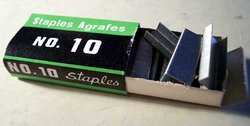Staple (fastener)
|
|
Staples also find use in medicine for the closing of incisions and wounds, a function also performed by sutures.
Staples have some advantages over other fasteners.
- Most kinds of staples are easier to produce than nails or screws.
- The crown of the staple can be used to bridge between two materials butted together.
- The crown of the staple can bridge over a piece and fasten it without puncturing with a leg on either side, e.g. fastening cable to wood framing.
- The crown of the staple provides greater surface area than other comparable fasteners. This is helpful with thinner materials.
The legs of a staple can be allowed to protrude out the back side and folded over to provide greater binding than the friction of straight legs. (Note: The term "stapling" is used for both fastening with straight or bent legs; however, when differentiating between the two, the term "tacking" is used for straight-leg stapling, while the term "stapling" is used for bent-leg stapling when being contrasted with "tacking".)
The most common staples are the ones used for paper. They are almost exclusively applied with a mechanical stapler which bend the legs after they pass through the paper. Staples for a paper stapler are made from bent wire and glued together to form a long strip of staples. The papers to be fastened are placed between the main body and the anvil. The papers are pinched between the body and the anvil then a drive blade pushes on the crown of the staple on the end of the staple strip. The staple breaks from the end of the strip and the legs of the staple are forced through the paper. As the legs hit the grooves in the anvil they are bent to hold the pages together. Many staplers have an anvil in the form of a "pinning" or "stapling" switch. This allows a choice between bending out or in. The outward bent staples are easier to remove and are for temporary fastening "pinning". Most staplers are capable of stapling without the anvil to drive straight leg staples for tacking.
Staple guns do not have anvils and are exclusively used for tacking. They typically have staples made from thicker metal. Some staple guns have round heads for fastening small cables, e.g. phone or cable TV, without damaging the cable.
Staples for larger cables are typically driven by hand with a hammer as are staples for fencing.
The large staples found on corrugated cardboard boxes have folded legs, but they are applied from the outside and do not use an anvil; jaw-like appendages push through the cardboard alongside the legs and bend them from the outside.
Saddle stitch staplers, also known as "booklet staplers," feature a longer reach from the pivot point than general-purpose staplers and are used to bind pages into a booklet or "signature".
Saddle stitch staplers such as the Ring King can also use "loop-staples" that enable the user to integrate folded matter into ring books and binders.
See also
External links
- Office Museum (http://www.officemuseum.com/staplers.htm) - History of the Staplerde:Heftklammer

